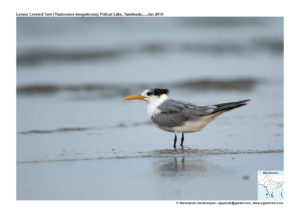Lesser-crested Tern

Lesser-crested Tern Thalasseus bengalensis
Etymology:
- Thalasseus : Greek word for Fisherman derived from thalassa – sea
- Bengalensis: From Bengal, India
Vernacular Names: Guj: Nanidariyayivabagali,Ta: Kondaiaala, Sinh: Muhudulihiniya, Mald:Iammutiegardooni, Mar: LahanTurewalaSuray
Distribution in India: Widespread winter visitor except North, North West and parts of East India.
Description: Size of 35–43 cm; wt. of 185–242 g; wingspan of 88–105 cm. The cap and crest are black; upperparts are uniform grey; bill is orange to orange-yellow with yellow distal area, and slight droop towards tip; legs and feet are black with yellow webs; iris is brown. The underparts are white, apparently less often tinged with pink. The non-breeding adult has white on forehead and crown and yellower bill. The juvenile paler and less heavily spotted and with darker flight-feathers, has dusky grey band across upperwing-coverts.
Habitat: It is found in tropical and subtropical coasts. It breeds on low-lying sandy and coral islands and coral flats. It migrates along coasts, resting on beaches and frequently loitering at estuaries.
Food habits: It eats fish, shrimps, herrings and prawns. It quarters above water, turning, hovering and plunge-diving, often submerging and also surface-dips. It often feeds in large mixed tern flocks. It suffers heavy piracy from Silver Gulls. It forages in surf and ranges offshore
Breeding habits: They breed in May–June in Persian Gulf; July–August in Libya; Aug in Somalia; in Australia, breeds September–December in E, March–June in N and both seasons in W. .The nest is a shallow unlined scrape in sand or shells, usually selecting ridges or bare areas surrounded by vegetation. They lay a clutch of 1 egg. The incubation period is 21–26 days. The eggs are attended continuously during a 24 h period, without leaving the nest in order to prevent the eggs from reaching lethal temperatures. The chicks are led from nest at 2–4 days, and fed outside colony; from day 7 chicks of mixed ages form crèche, protected by adults. The fledging period is 30–35 days and parental care extends to age of 5 months.